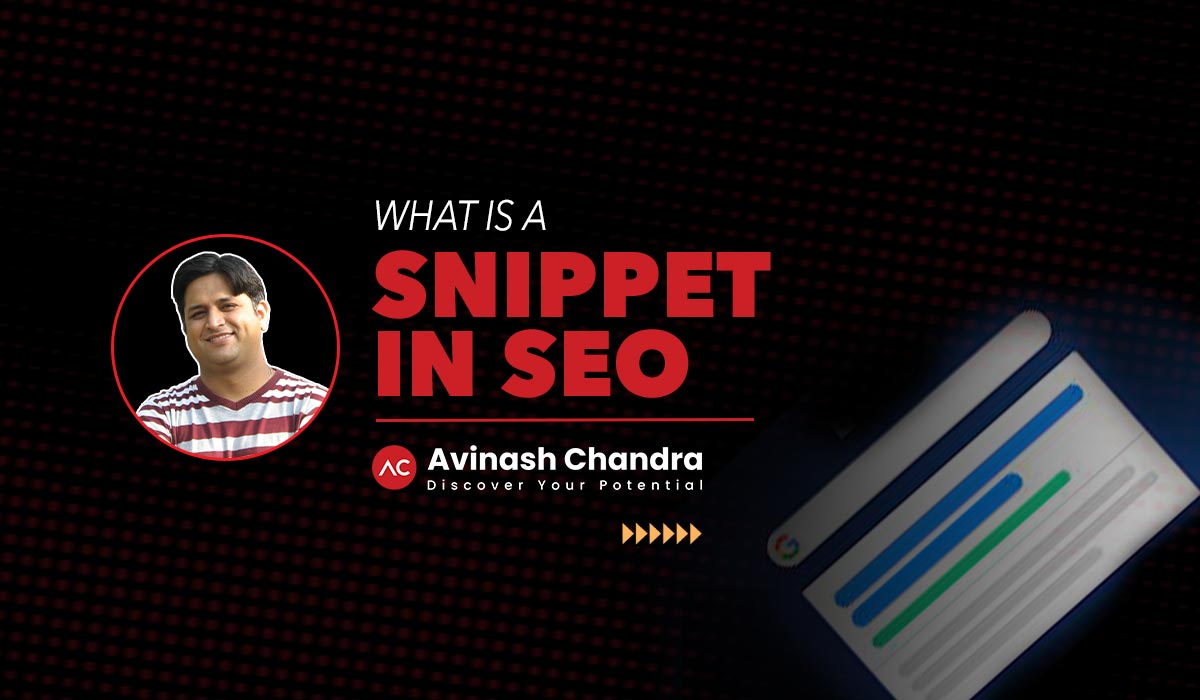Have you ever done a Google search and seen those small boxed descriptions of websites in the results? You know, the ones with a title, URL, and a brief description. Those are snippets, and they play an essential part in SEO, which stands for search engine optimization.
Google’s algorithm automatically generates the boxed summaries based on the most relevant elements of a webpage. So, website owners like myself spend a lot of effort optimizing title tags, meta descriptions, content, and so on to ensure that Google chooses the correct snippet.
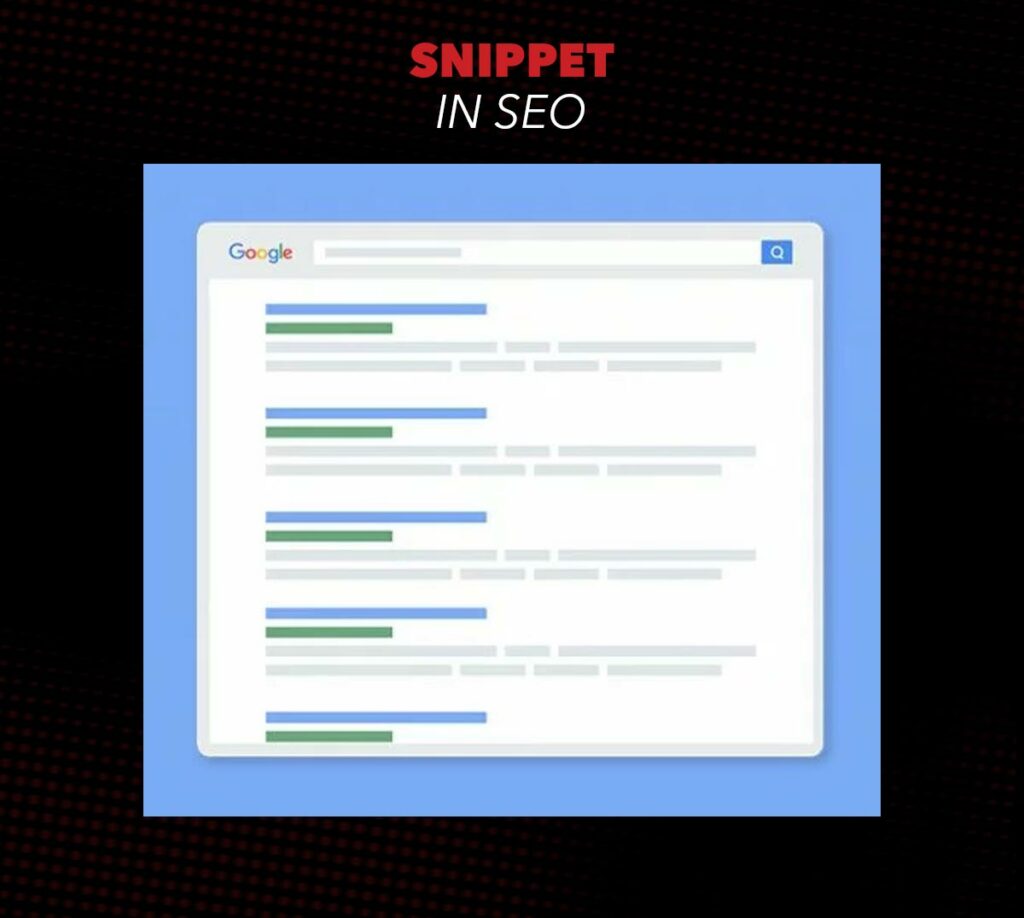
So, you probably wonder why we spend so much effort on a snippet.
According to research, 60% of all clicks go to the first search result, and a fascinating snippet may boost your click-through rate by 2-3 times.
Moreover, with the appropriate emphasis, we can nail these snippets and attract more satisfied users to our websites. In this blog, I will cover everything you need to know about snippets and how you can use them optimally to improve your click-through rate by 3x.
Discover SEO basics and its impact on digital visibility. Learn how it works, key strategies for ranking higher, and tips to optimize your site.
What does a Snippet mean in SEO?
A snippet in SEO is a brief description of a web page that search engines like Google present in their search results. A snippet is the page title, meta description, and URL displayed for each result.
These snippets are essential for SEO since they encourage searchers to click on your website. The snippet provides a glimpse of what the user might anticipate discovering on that page. This indicates that optimizing snippets is critical for increasing click-through rates.
There are three primary components of a search snippet that may be optimized:
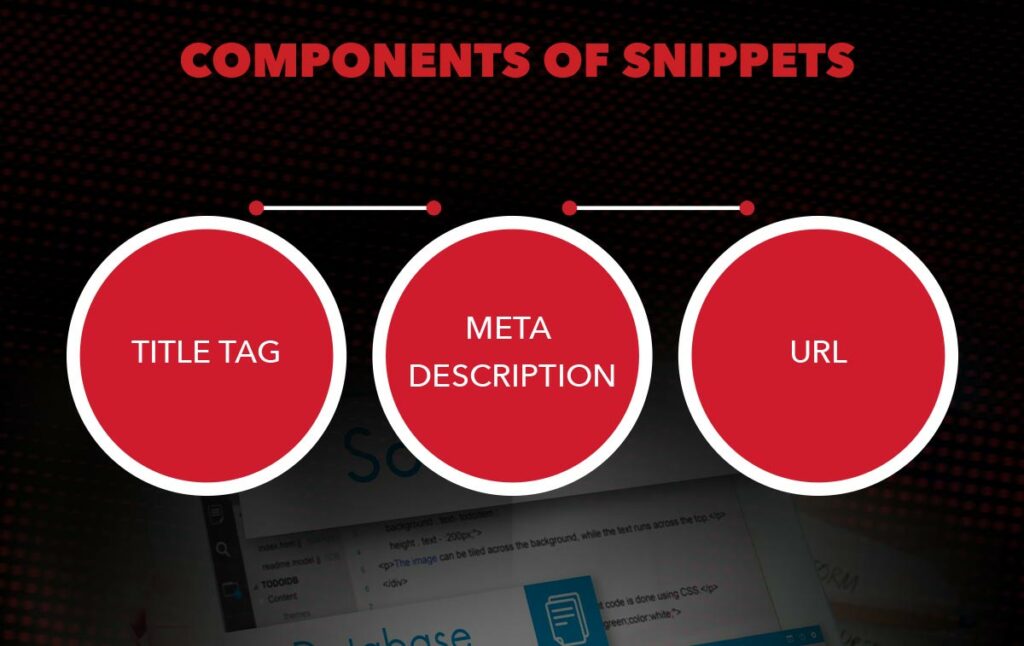
1. Title Tag:
The title tag is the primary headline, which appears in bold at the top of the excerpt. It should be detailed yet brief, clearly explaining the page’s topic and purpose. Title tags can include up to 600 characters. However, snippets often display just the first 50-60 characters.
2. Meta Description
The meta description is the text snippet behind the title that explains the page’s content. Well-written meta descriptions will provide additional information about the page’s offerings and attract the searcher to click. Meta descriptions can be 300 characters or more significant, although snippets often contain 156-158 characters.
3. URL
The URL component of a search snippet refers to the actual site address that appears underneath the title and meta description. Though tiny, the URL also influences click-through rates. URLs should be simple, keyword-rich, and include the domain name to increase trust.
Looking for top SEO results in Bangalore? BrandLoom offers unmatched expertise, cutting-edge strategies, and customized solutions for your success.
An optimized, understandable URL corresponding to the content seems more professional in snippets and stimulates more clicks.
By optimizing title tags and meta descriptions for each page, you can significantly increase click-through rates. Pages containing optimized snippets, for example, can obtain more than 5% click-through rates compared to 1% without. As a consequence, more visitors will find your website through organic search.
Importance of Snippets for SEO
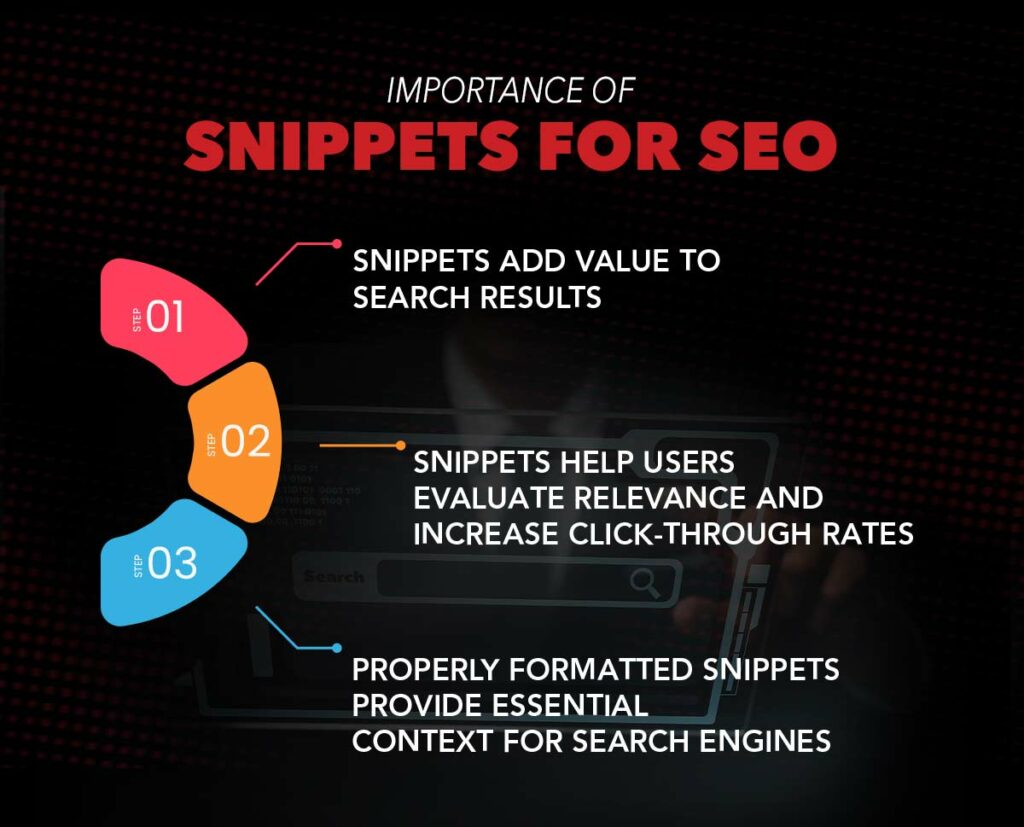
1. Snippets Add Value to Search Results:
When users search for particular code questions or answers, search engines attempt to return relevant snippets immediately on the search results page, allowing the user to rapidly answer their inquiry without having to go through other websites. Putting detailed, well-formatted code snippets on pages about programming how-tos and tutorials increases the likelihood that your material will appear in those vital snippet locations in the SERP.
2. Snippets Help Users Evaluate Relevance and Increase Click-Through Rates:
Snippets provide searchers with a preview of the actual code and code syntax that will appear on your page, allowing them to decide whether your information is relevant to their needs more efficiently. This improves the likelihood that they will click over from the search results to your website. It also indicates to search engines that your page contains code solutions, which helps it rank for code-related keyword searches.
Unlock your website’s potential with Pune’s leading SEO company. Expert strategies, personalized service, and proven results to elevate your brand.
3. Properly formatted snippets provide essential context for search engines:
Use syntax highlighting and comments within snippets to make code easier to comprehend from search results. Properly arranging your snippets with syntax highlighting, line numbers, and informative text summaries allows search engines to understand not just what your code is but also how it works and addresses the user’s problem. This contextual information in snippets is critical for search engines to determine whether to display your material in response to technical inquiries that may require code to respond.
Types of Snippets
In search engine optimization (SEO), several sorts of snippets play an essential role in increasing the visibility and relevancy of information in search engine results pages (SERPs).
These snippets are intended to present consumers with concise and sound samples of web page content, allowing them to make more educated choices about which search results to click on.
Understanding the various sorts of snippets may assist website owners and content writers in optimizing their material for greater visibility and user interaction.
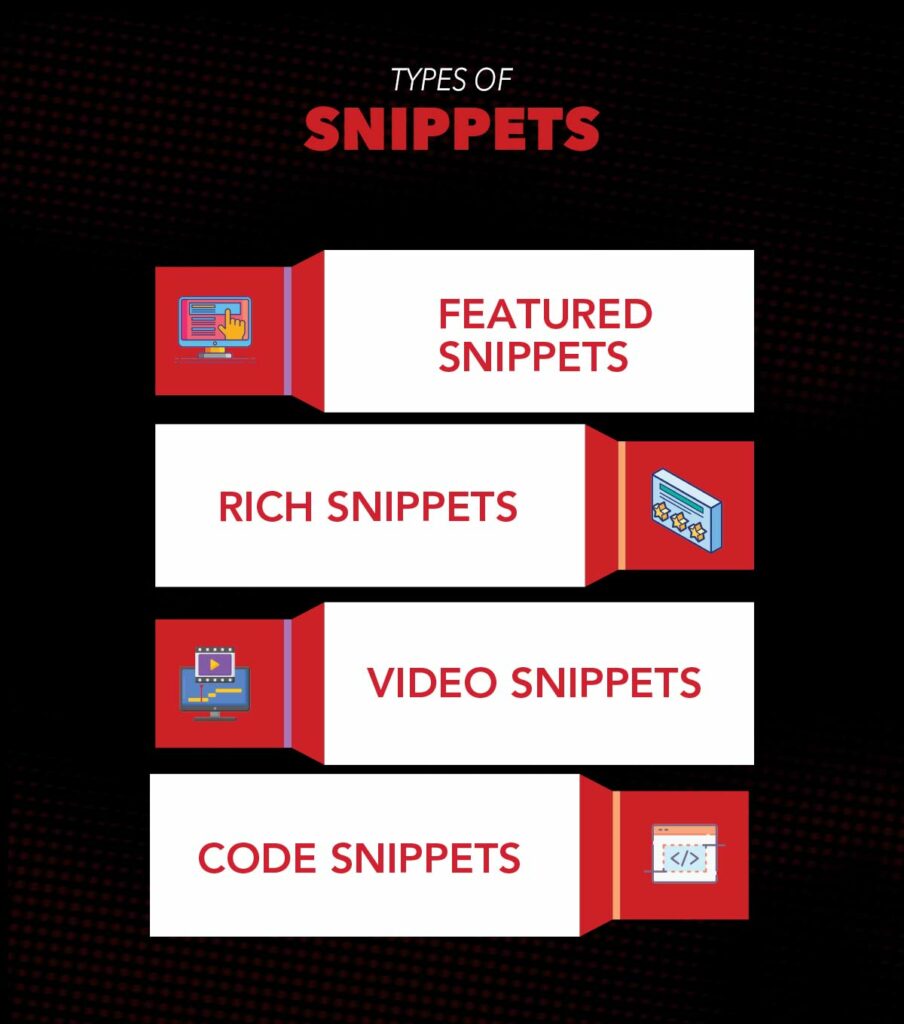
1. Featured Snippets:
Featured snippets, or “position zero,” appear at the top of search results pages in response to specified searches. These snippets attempt to answer user inquiries directly, making them extremely useful for boosting organic traffic and building expertise in a specific topic or business.
Elevate your online presence with Gurgaon’s premier SEO company. Tailored strategies, expert analysis, and impactful results to drive your success.
2. Rich Snippets:
Rich Snippets enhance search results by presenting ratings, reviews, product prices, and event information. Website owners that use structured data markup can assist search engines grasp the context of their material, resulting in more visually appealing and helpful search results.
3. Video Snippets:
Video snippets give consumers a glimpse of associated video material in search results. Optimizing video content with relevant metadata, transcripts, and appealing images increases the probability that video snippets will appear in SERPs, driving traffic to the linked web pages or video platforms.
4. Code Snippets:
They are handy for programming and technical information. When correctly organized and optimized, code snippets can appear in search results, giving consumers quick access to code solutions and lessons while enhancing the exposure and credibility of coding-related information.
Understanding and implementing these snippets may significantly influence a website’s SEO performance, increasing organic traffic and user engagement.
Boost your digital footprint with Mumbai’s top SEO company. Innovative strategies, personalized service, and measurable results for your business.
Why Does Snippet Optimization Matter?
Snippet optimization is critical for increasing a website’s exposure, generating organic traffic, and giving consumers useful, concise information right on search engine results pages (SERPs). Website owners and content writers may improve their SEO performance and user engagement by concentrating on snippet optimization. Here are a few reasons why snippet optimization is essential:
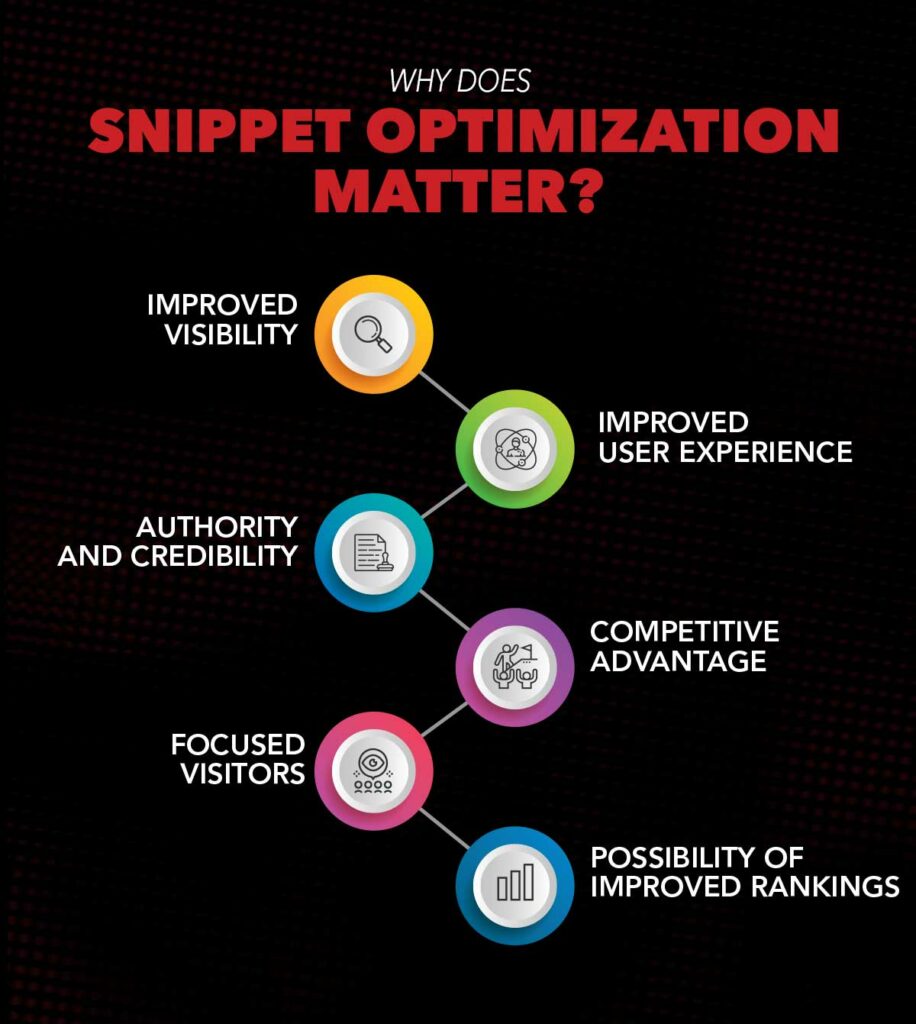
1. Improved Visibility:
Optimizing snippets boosts content visibility in search results, including highlighted snippets, rich snippets, and specialized result kinds. This enhanced visibility can result in more excellent click-through rates and organic website visitors.
2. Improved User Experience:
Optimized snippets offer brief and relevant information, allowing consumers to rapidly assess the value of a web page before going through. This enhances the user experience by enabling consumers to find the required information quickly.
3. Authority and Credibility:
Featured and rich snippets establish a website as an authoritative source in its industry or area. Snippet optimization may boost a website’s credibility and trustworthiness in visitors’ eyes by including straight replies, ratings, reviews, or other important material in search results.
4. Competitive Advantage:
Optimizing website snippets can provide a competitive advantage in search results, particularly for targeted queries or themes. A website with well-crafted and interesting snippets might draw more attention and clicks than rivals with less optimized snippets.
5. Focused visitors:
Optimized snippets effectively depict web page content, resulting in more focused visitors. This can result in improved conversion rates and more engagement with the website’s services.
To summarize, snippet optimization is essential since it directly affects a website’s visibility, user experience, authority, competitive advantage, and quality of traffic it receives. By concentrating on snippet optimization, website owners may enhance their overall SEO performance and better suit the demands of people looking for relevant information.
6. Possibility of Improved Rankings:
Rich snippets can raise website click-through rates by giving more thorough and pertinent information in search results. Rich snippet websites may gradually gain ranking due to positive feedback loops formed by users finding the content valuable, which drives more traffic and further enhancements to search visibility. This is because clicks signal relevance and user happiness to search engines like Google.
Maximize your online visibility with Delhi NCR’s leading SEO company. Expert tactics, customized solutions, and proven success to grow your business.
How To Optimize Title Tags
Optimizing title tags is essential to on-page SEO since they directly affect a website’s visibility in search engine results and user click-through rates. Here’s a section on optimizing title tags.
Title tags should be between 50 and 60 characters extended to guarantee correct presentation in search results. While search engines may display lengthier titles, staying within this range ensures that consumers can see the complete title.
Best practices for writing compelling titles:
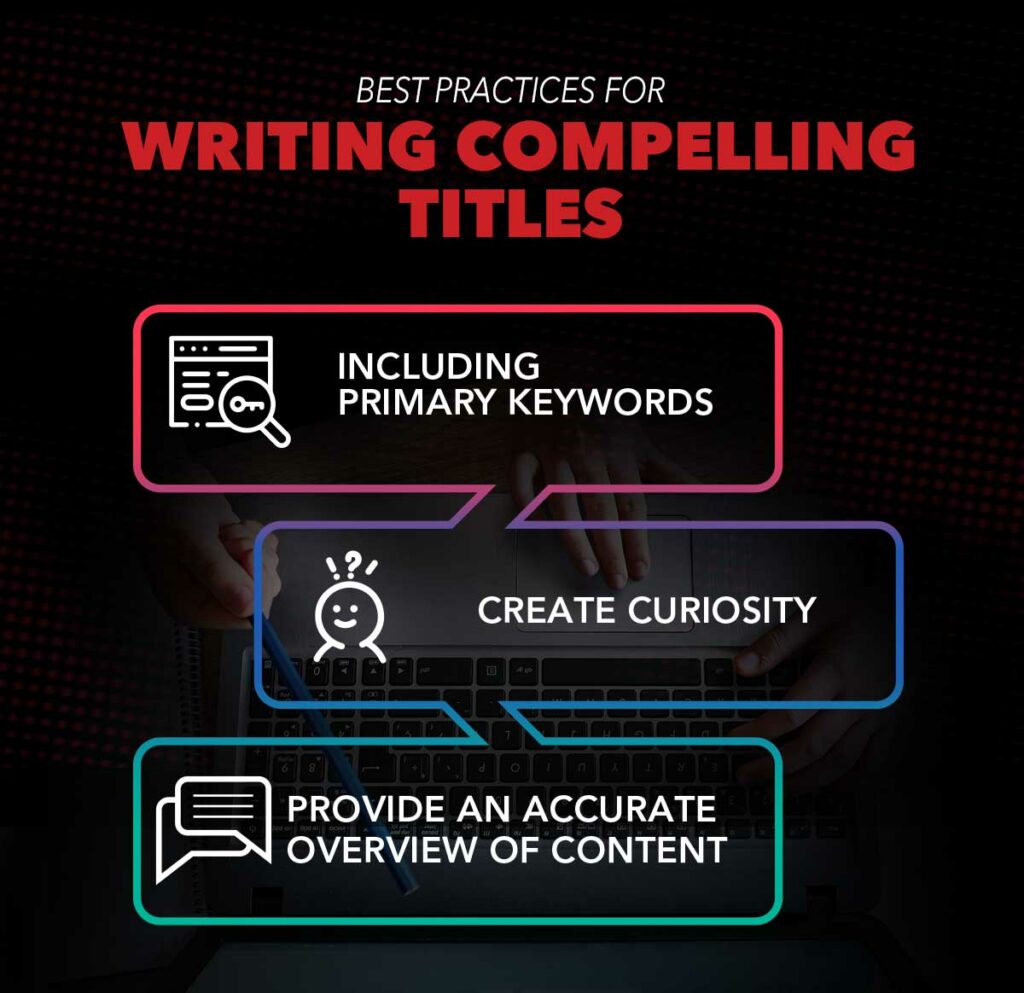
1. Include Primary Keywords:
Including core keywords in the title tag helps search engines comprehend the page’s content and relevance to user searches. However, keywords should be included organically, not interfering with the title’s readability or flow.
2. Create Curiosity:
Employ titles that arouse curiosity or provide a fresh perspective to increase click-through rates. Including engaging language or hints at significant insights in the title might persuade people to read further.
3. Provide an Accurate Overview of Content:
Title tags should represent the page’s content to provide a realistic overview of the material. Misleading or clickbait headlines can create an unpleasant user experience and increase bounce rates. A clear and accurate summary of the information helps establish acceptable user expectations.
In conclusion, optimizing title tags includes sticking to optimal length and character restrictions, generating engaging titles that incorporate primary keywords, eliciting curiosity, and offering an accurate synopsis of the content. By implementing these best practices, website owners may increase their pages’ visibility and click-through rates in search results.
Transform your online presence with India’s best SEO company. Experience unparalleled expertise, innovative strategies, and dynamic results.
How To Optimize Meta Description
Meta description optimization is critical for increasing click-through rates and delivering useful information to consumers in search engine results.
Meta descriptions should be extended between 150 and 160 characters to guarantee they appear correctly in search results. While search engines may display lengthier descriptions, keeping them within this range ensures readers receive concise and powerful information.
Best Practices for Writing Meta Descriptions:
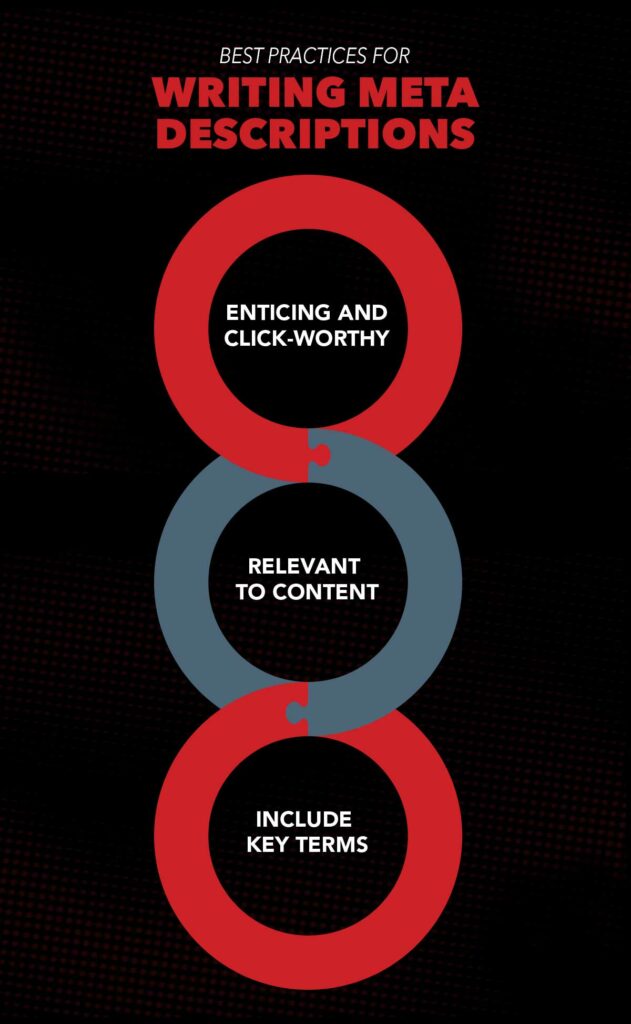
1. Enticing and Clickworthy:
To make meta descriptions more appealing and clickable, use action-oriented language, ask questions, or provide solutions. A call to action or showcasing unique selling aspects might motivate people to navigate the website.
2. Relevant to Content:
Meta descriptions should be relevant to the page’s content. Misleading or inappropriate descriptions can create an unpleasant user experience and increase bounce rates. A clear and accurate summary of the information helps establish acceptable user expectations.
3. Include Key Terms:
Adding essential phrases or keywords to the meta description might improve the page’s relevancy to specific search searches. However, it is critical to ensure that keywords are employed organically and do not disrupt the reading or flow of the description.
Improving meta descriptions entails staying under character restrictions, following best practices for engaging and relevant descriptions, and using essential phrases to reinforce the page’s relevance to search searches. By concentrating on these factors, website owners may increase click-through rates and user engagement for their pages in search results.
Best Practices For Rich Snippets
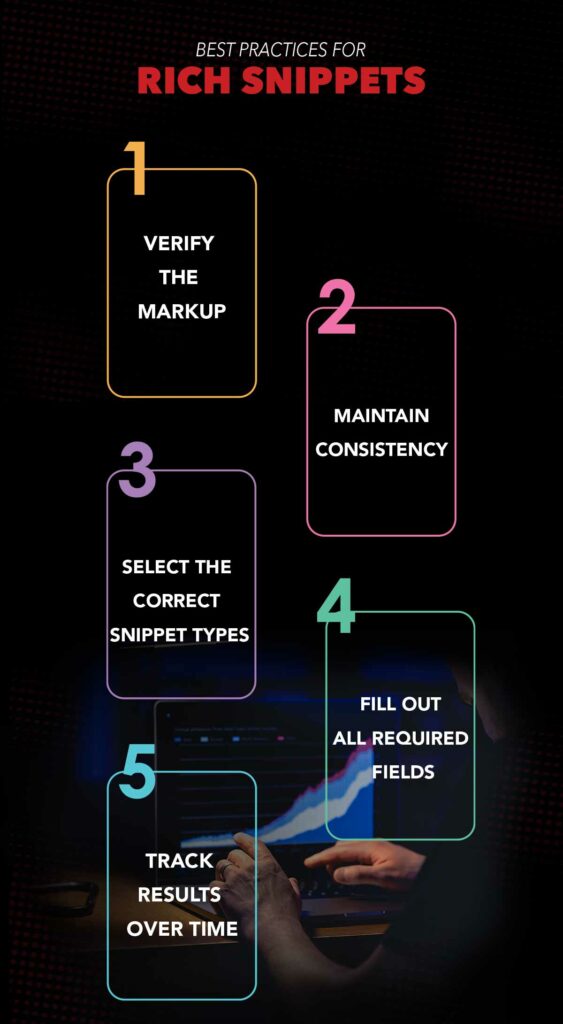
1. Verify the Markup
Site owners should use Google’s structured data testing tool to verify the structured data markup is valid before using rich snippets. This tool will look for code problems that prevent snippets from showing correctly. Missing fields, incorrect formatting, and other syntactic problems are examples of errors. Before releasing pages, it is crucial to address any flaws discovered to prevent losing out on any SEO benefits.
2. Maintain Consistency
All pertinent pages on a website should uniformly use rich snippets for a cohesive user experience. Wherever possible, utilize the same fields and snippet kinds. For instance, rather than having some product pages use Thing and some use Product, all product pages should use the Product snippet. Search engines can better understand the kinds of material a website has when there is consistency.
3. Select the Correct Snippet Types
Site owners are responsible for choosing the most precise snippet type for each page. More general categories like Thing might not adequately highlight the page’s topic compared to Product or Recipe. Selecting the appropriate form of snippet aids search engines in comprehending the website’s content and how it ought to appear in search results.
4. Fill Out All Required Fields
When using rich snippets, include all the fields that Google indicated as necessary for that specific kind. For instance, parameters like name, image, description, and availability are required for product snippets. Ignoring crucial features prevents the snippet from demonstrating its full potential and usefulness. Robust structured data contributes to the delivery of more engaging click experiences.
5. Track Results Over Time
You can track rich snippet coverage and performance with Google Search Console. This aids in locating any problems stopping the desired snippets from showing up. Additionally, it shows how search visibility varies over time. Consistent observation guarantees that snippets keep working as intended, providing the user experience and search engine optimization advantages for which they provide.
Conclusion
To conclude, snippets are a significant tool for helping websites rank better in search results. While SEO includes several sophisticated algorithms and signals, snippets give immediate value to search engines and people.
For search engines like Google, snippets give helpful contextual information about a website’s content in a compact, scannable manner. Well-optimized code snippets in page content help search engines grasp the technical nature of pages and how they might meet user demands.
Snippets in search results are valuable for users. They let visitors immediately examine the code structure and functionality or answer their query within the search engine without visiting the page.
For website owners, placing optimized snippets on relevant pages and optimizing them for search engines can aid with technical SEO. Key features include utilizing informative snippet names, clarifying the code context and advantages, and ensuring that snippets are well-structured and presented. Internal linking to snippet-heavy pages further improves the site’s structure.
Frequently Asked Questions on Snippet
To generate rich snippets, optimize code snippets on web pages using descriptive meta tags that give more information to search engines. Use Schema.org markup and meta tags like <code>, <pre>, and <script type=” application/ld+json”> to annotate code snippets as ProgramCode.
The meta tags and Schema.org scripts describe the code snippet’s function, purpose, technologies utilized, and how users may benefit. Use the Google Structured Data Testing Tool to test the snippets’ formatting and display. Rich snippets help search engines better understand technical sites and code material.
Rich snippets are improved search results in SERPs to give additional insight into page content. Rich snippets enable search engines to present extra technical facts directly in the search preview without requiring a click.
This comprises information such as the programming language, authors, a description of what the code sample does, and other pertinent metadata. Setting up rich snippets entails adding structured data markups like JSON-LD and certain meta tags to code-filled pages.
When done correctly, it tells search engines how to augment their snippet presentation with a more technical background, allowing developers to find helpful code samples.
A brief piece of code that is added to a webpage and optimized to aid in search engine optimization is known as an SEO snippet. Code snippets are a frequent way to show programming functions, solutions, and strategies on blogs, developer documentation sites, and other technical pages. The code snippet should accomplish a few objectives for SEO.
It is essential to provide a comprehensive explanation, complete with descriptive context, of the problem the code resolves or the steps it instructs developers on. This aids in the technical topic of the page content’s understanding by search engines.
Additionally, the sample has to have keywords related to popular search queries in the variable names, code comments, and surrounding language. To better optimize the snippet, use technical meta descriptions.
Search engines may identify the snippet as reusable code and present improved rich snippets in search results using proper structured data markup, such as JSON-LD. Thanks to this, developers may access improved technical previews without having to click through. All things considered, well-crafted SEO snippets give search engines contextual cues to assess technical pages more favorably and give developers searching for code samples or solutions more pertinent previews.
The preview snippet or summary that shows up on a search engine results page (SERP) for a certain website or page is known as a SERP snippet. The search engine results page, or SERP, presents condensed versions of text and other information from pertinent web pages when someone searches online. When a page has code snippets, the SERP snippet attempts to give a useful sneak peek at the code in question.
Rich snippets are produced by search engines in the SERP by well-optimized code snippets combined with structured data and informative meta tags. These “rich snippets” might contain the code preview and more technical information about the programming language, the author, and a synopsis of what the code sample demonstrates to developers.
By doing this, searchers may quickly determine from the SERP if a page will be helpful without going through and loading the entire page. Rich SERP snippets make it easier for developers to locate code answers to their searches quickly.
Developers and SEO experts may verify if structured data on their pages, such as code samples, will appear correctly as rich snippets in search engine results by using a website known as a rich snippet testing tool.
The Google Structured Data Testing Tool is the most widely used. This online validator checks for syntax mistakes or missing properties in markup implementations such as RDFa, microdata, and JSON-LD.
Next, if Google were to index and surface the page, a preview of the rich snippet would appear. Users may use this to confirm that their structured data configuration is correct and that technical information, such as the code description and language, will display in the rich snippet as planned. It is crucial to conduct frequent testing with this tool to optimize rich snippets and monitor for any modifications to structured data principles.
Rich snippets’ visible information may be enhanced by adding more metadata to structured data for code snippets, a feature known as “structured snippet extensions.” The essential metadata required is using Schema.org to identify the snippet as ProgramCode and appending a description. Extensions, however, let you include more helpful information.
The programming language(s) used, whether the snippet is complete code or an extract, who wrote it when it was developed or last updated, and what software libraries/APIs it uses. For instance, a brief description of the problem it solves or illustrates might all be specified in an extension. Extensions may include ratings, tags, and categories to assist users in finding pertinent snippets.
By using these extensions, search engines can give rich snippets of additional technical detail without requiring visitors to see the entire page. Based on the languages utilized, freshness, and other aspects communicated at a look, developers can rapidly determine a snippet’s purpose and choose whether it warrants opening. Thus, through efficient, rich snippet displays, well-implemented structured snippet extensions increase the discoverability of code samples.
It is frequently permissible to copy and reuse small portions of code from one programming project into another. Nonetheless, there are a few crucial things to remember. Before anything else, ensure you have permission to use the code from the sample legally. Verify whether it is free of copyright limitations and has a permissive license.
Additionally, it’s a good idea to expand or change the copied passage rather than duplicate it word for word. This keeps possible licensing problems at bay and demonstrates your understanding of the code as opposed to mindless copying. When reusing a snippet, appropriately credit the original author and project.
Instead of copying entire blocks of code, only copy tiny, self-contained portions. More significant amounts could be regarded as derivative work or breach of license. Since behaviors may change, properly test any copied pieces in the context of the new project. Lastly, if you edit the copy, make sure the original snippet is updated so that people in the future may access the most recent version.
Selectively copying code fragments between projects can be a valuable technique to reuse pre-existing code solutions, as long as the proper safeguards and adjustments are taken. However, always remember to honor credit and license.

